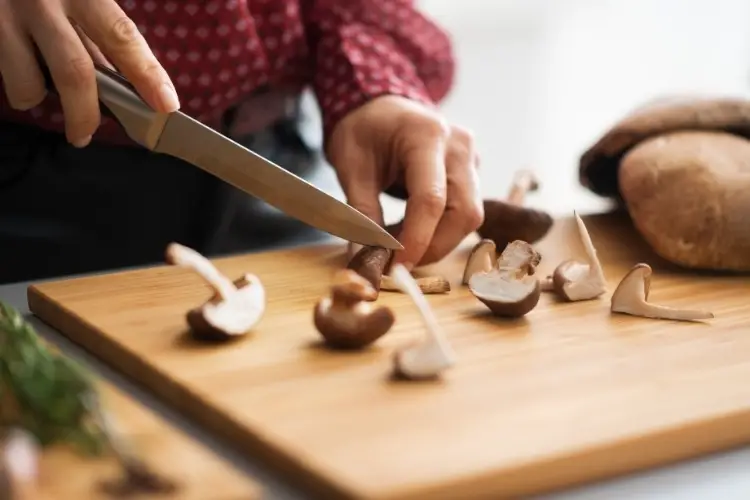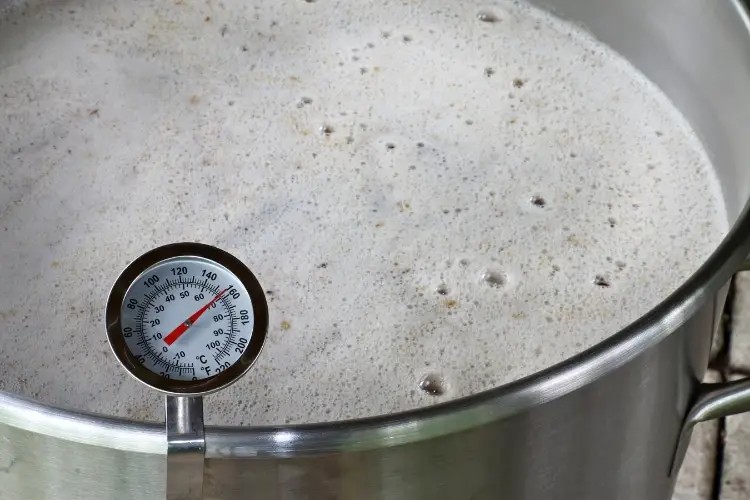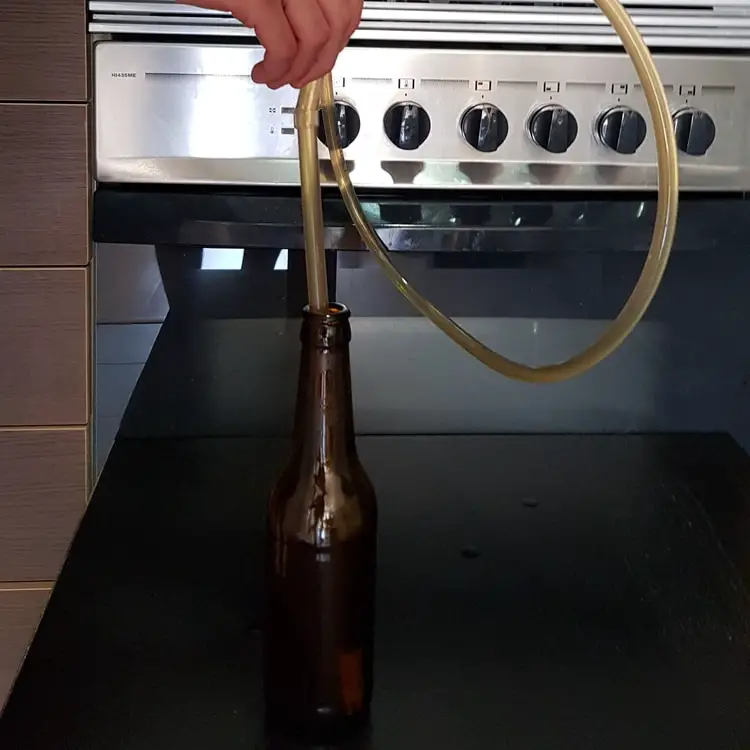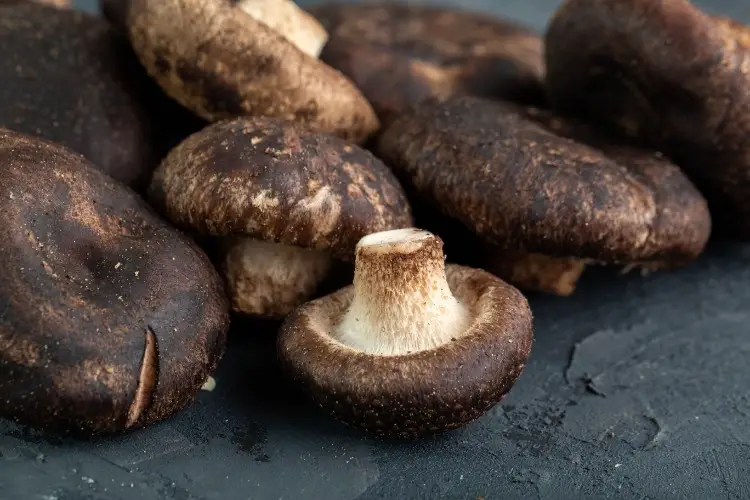A beer recipe is only as good as the ingredients that you will be fermenting. For some, the unique earthy taste of mushroom beer is a delicacy that goes well with many different types of meals. Ultimately, brewing beer with mushrooms gives the undeniably distinctive flavor and the scent of umami, which is challenging to obtain with brewing any other way.
The recipe for brewing craft mushroom beer can be completed by following the steps below:
- Prepare mushrooms
- Mash and boil mixture
- Boil the mixture
- Pitch yeast starter and aerate
- Add mushrooms
- Bottle final mushroom beer
The taste and color that mushrooms add to beer can be complementary and tasty. There are various types of fungi that give beer more robust and complex sensations for the palate. If you want to create genuinely outstanding mushroom beer, read on to find out more about the differences in mushrooms you can use and several recipes for these mushroom varieties.
Brewing Beer with Mushrooms Steps
You need to follow the general steps for brewing beer with mushrooms to get the signature umami taste and aroma of mushrooms to blend with the overall beer recipe.
If you can do these steps correctly for each mushroom beer recipe, you are sure to achieve the sought after aromatic and bold taste that mushrooms can add to a beer.
Umami is a much desired and hard to achieve taste in the cooking world.
Umami is the “fifth flavor” and is described as “savory”, not a flavor most connect to beer.
However, one way to create umami in beer is using mushrooms’ glutamic acid during the brewing process of heating and fermentation.
Umami taste and scent is another reason why brewers choose mushrooms for their beers.
You can use the steps listed below in any mushroom recipe. These steps will help to maintain a balance between sweet hoppiness and umami boldness.
1. Prepare Mushrooms
No matter which type of mushroom you plan to use in your beer recipe, all have similar preparation techniques.
You will need to use two forms of mushrooms in your beer recipe: powdered and raw.
The powdered form comes prepackaged and dehydrated, and you don’t need to do anything other than open the package and add it to your beer mixture.
You must process raw mushrooms before adding them to your beer recipe. To prepare fresh mushrooms, follow the steps below:
- Brush off the dirt from the mushrooms using a small vegetable brush. Do not add water to the mushrooms to clean them as this could change the boiling brew mixture’s chemistry when the mushrooms are added.
- Cut the mushrooms up into thick slices.
- Place the mushrooms either directly into the boil or get a submersible bag that you can use with dry hopping recipes and add the mushrooms that way.

2. Mash and Boil the Mixture
The process of mashing the mixture takes place in one pot where the milled malt or “grist” is mixed with water and heated to a temperature range of 144° to 153° F (62-67° C).
During this process, starch and enzymes break down into more easily fermentable sugars.
As the mixture boils, you need to stir with a paddle to prevent the mash from burning.
You can use either a wooden or stainless-steel paddle.
The process of mashing must be done in a boiling container, preferably made of stainless-steel, because of its ability to limit impurities and its durability as a cooking container.
Some of the best mash and boil brewing containers are listed below:
- Brewer’s Edge Mash and Boil
- Bayou Classic, Stainless-Steel Brew Kettle, 20 quart
- Ss Brewtech Home Brewing BrewMaster Kettle; Stainless-Steel

3. Separate the Wort
Wort is the liquid sugar that has been separated from the rest of the mixture during the boil and mash period of brewing.
The wort needs to be filtered out in some way from the rest of the mix.
There are several steps when separating the wort from the mash
When separating the wort, there are three things you want to achieve:
- Clear wort: Wort material that is free from residue and other impurities.
- Quality extract material: The thickness of the extracted wort material should not be burnt or too liquidy. The color should not be brown or black.
- Finish within the time frame of brewing step: Do not take too long, or you risk overcooking the mash and burning the wort. If you do not prepare for long enough, the sugars will not form. Sugars from the grains are essential to the rest of the fermentation process.
There are four main strategies for separating the wort from the rest of the mash. Each method requires a specific tool.
The four methods of wort separation are listed below with the tools you will need for each.
- The Mash Tun: The mash tun is a container that holds the boiled grain and wort with a metal mesh filter or calendar at the bottom. Some of the best mash tuns are:
- The Lauter Tun: The lauter tun is a false bottom of the mash container that separates the grain sediment from the wort. The lauter tun method allows the wort to drain through it while leaving the grain pieces up top. Some of the most popular lauter tuns are:
- The Mash Filter: Another way to separate the wort from the mash is a mash filter. The mash filter is a device that acts as a press with a frame and a screen that presses the wort out of the solid mash.Some of the best mash filters are listed below:
- Strainmaster: A strainmaster is a wort filter method that has a series of tubes that are perforated and recirculate the wort over the spent grain of the mash. As the wort becomes more apparent, the pipes are diverted into a fermentation chamber for the final steps of fermentation. These tools are costly and only for professional large batches production of beer.
4. Pitch Yeast Starter and Aerate
You should aerate the wort after it is boiled and cooled before you pitch the yeast.
Oxygen is needed for the yeast to reproduce and grow, starting the fermentation process.
Aeration is the catalyst for the fermentation process.
There are several processes for aerating the wort after it has been poured into the fermentation container:
- Rock the container: After the wort is poured into the fermentation container, it can be gently lifted and rocked back and forth to introduce oxygen to the wort mixture.
- Whisk: If the fermentation container is a large-mouthed stainless steel or plastic container, then a whisk that you might find in your kitchen can be used to whisk up the wort and froth in some oxygen. Make sure the whisk is sanitized before inserting it into the mixture.
- Use pure oxygen: A canister of oxygen gas with a nozzle and tube can be inserted into the wort and inject some oxygen into the wort. Make sure that the tubing and nozzle are sanitized before entering the mixture.
After the aeration process is done, you will pitch your yeast and add water.
Pitching yeast and adding water creates your final beer mixture in the fermentation container.
“Pitching” means adding the required yeast with the right amount of water in the mix for your final brew volume.
Some recipes may require pitching different yeasts at different times or even be pitched at various time intervals throughout the fermentation process.
For this recipe, pitch yeast before aerating.
5. Add Mushrooms
The mushrooms that you use for your recipe will need to be added in different ways.
Some recipes call for powdered mushroom and raw, some call for just one or the other.
You may also want to cut and place in a dry hop bag and then submerge in the final fermentation container for several days and up to a couple of weeks.
Powdered mushrooms come already prepared in bags and can be found at most brewing stores or some grocery stores.
The steps for adding powdered mushrooms are easy; you simply measure out the desired weight in grams or ounces and pour the powder into the fermentation mixture.
Most recipes with powdered mushroom have multiple times when the powder should be added.
Raw mushrooms must be clean and processed before being added to the beer fermentation mixture.
Cleaning should not be done with water as mushroom taste will come through in the batch better with dry mushrooms.
- Brush off dirt and then process by cutting into slices.
- The slices can be frozen for two weeks and then thawed.
- Finally, add the mushrooms to a mesh brewer’s bag and submerge in the fermentation mixture as the recipe states.
6. Bottle Final Mushroom Beer
Bottling single bottles can take a long time.
If you do not have a built-in spigot, it can be downright tricky.
To fill single bottles of your finished and fermented mushroom beer use a siphon method listed below:
- Use quarter-inch tubing that has been sanitized. Tape the tube to the side so that it is directly above any sediment that may be at the bottom of the container.
- Siphon by sucking on the end of the tube and then place the pipe below the height of the container into the single bottles. Gravity will carry the liquid down the tube into the bottle.
- Pour the beer from the tube at an angle to avoid foaming and overflow.
- Fill all single bottles that you have until the container is empty.
- Cap each bottle with a table-top capper or a handheld capper.

Brewing Beer with Mushrooms Recipes
While the steps to complete different mushroom brews are similar, there are some slight variations in the recipes that will be detailed in the following methods.
The differences in the recipes mostly have to do with the flavor and consistency of the mushroom types that you can use.
Some of the best mushroom beer recipes are:
- Porcini Paradise Recipe
- Raw Mushroom Recipe
- Sweet Shroom Recipe
- The Fungus Among Us Recipe
Porcini Paradise Recipe
Porcini is a mushroom that will add bold flavor to your beer.
Make sure to find mushrooms that are fresh for your batch, which means that they look lighter without a dark cap and no black spots on the stalk.
Also, avoid bags of porcini that have small parts and dust as these will probably provide less taste.
The Porcini Paradise recipe requires the following ingredients and schedule to make a five-gallon batch:
| Ingredient Type | Ingredient Details |
| Malt and Grain |
|
| Hops and Additionals |
|
| Yeast |
|
Recipe Steps
- Boil the mash at 149 degrees Fahrenheit (65° C) for sixty minutes.
- Add 0.7 oz Northern Brewer at 30 minutes while stirring occasionally.
- Add 0.7 oz Northern Brewer at 60 minutes while stirring occasionally.
- After fifty minutes, add the three ounces of powdered Italian porcini. You can add the powder to the boiling kettle. You should see and smell a difference almost immediately from sweet hops to a robust stew scent.
- Add 0.7 oz Northern Brewer at flame out and let sit.
- While sitting, add 5 oz powdered Italian porcini in secondary for seven days.
- Add 3 oz whole dried Colorado porcini in secondary for three days.
- Add the WLP810 San Francisco Lager yeast and ferment the beer at around 64°F (18°C) for two weeks’ primary fermentation or until the beer reaches a terminal gravity of 1.018.
Porcini adds a full body and decadence to the beer and brings out the umami taste in a bold way.
The aromatic umami flavor that this recipe creates could also be made with a fermentation because of the strong capability of producing the fragrant taste of umami with the Brettanomyces variety of yeast.
This recipe is the most difficult to create because of the long conditioning process and also the multiple ingredients that need to be pitched at various times throughout the boil.
It would be wise to try other mushroom beer recipes before attempting this one.
Raw Mushroom Recipe
If you want to retain only the fresh taste and aroma of mushrooms without the addition of mushroom powder, this recipe is a great one for creating robust and high gravity mushroom beer.
However, this recipe is also more advanced than others and can take up to two months to be fully completed and ready to drink.
This recipe depends on the quality and preparation of fresh mushrooms that are cut and submerged for the taste to come through.
Other mushroom recipes do not require mushrooms to be raw and can be mixed with sugars instead of grains and even other mushroom powders.
The Raw Mushroom recipe requires the following ingredients and schedule to make a five-gallon batch:
| Ingredient Type | Ingredient Details |
| Malt and Grain |
|
| Hops and Additionals |
|
| Yeast |
|
Recipe Steps
- Mash the 4 oz roasted barley to 450°F (230°C) and boil down the 20 lb Simpson’s Golden Promise malt mixture for ninety minutes. You should see that the grain pieces separate after boiling at 154°F (67°C) for a majority of the ninety minutes.
- Add 1 tsp Irish moss at fifteen minutes while stirring occasionally.
- Add 1.1 oz Northern Brewer hops, 10% a.a. at forty-five minutes while stirring occasionally.
- Runoff the excess liquid and remove one gallon of the first runnings of wort boil down.
- Boil the first runnings for an additional ninety minutes.
- Cool the wort to around 55°F (13°C)
- Pitch yeast and aerate well with the method that will work best for your fermentation container.
- Fermentation can take anywhere from two to four weeks for this mushroom beer, so be patient and listen to the gas release valve’s burps which will lessen as the fermentation is completed.
- Prepare the raw mushrooms.
- When the final combined gravity of 9.6% ABV has been reached, add the two pounds of chanterelle mushrooms. Leave the mushrooms in a sanitized mesh bag in the fermentation container with the final gravity beer for at least two weeks.
- Cold condition around 34°F (1°C) for about a month.
- Keg or bottle with carbonation.
Since this recipe takes so long to ferment and then cold condition, it should be followed carefully, and sanitation should be of the utmost importance.
The taste and aroma of raw mushrooms in the final beer are more subtle than other mushroom beers with powdered mushroom ingredients.
Also, the umami taste is gentle and sophisticated but does not overpower the intense gravity of the beer.
Sweet Shroom Recipe
Adding more sugar to the recipe for mushroom beer allows for a sweeter and quicker fermentation process.
This is a great mushroom beer for beginners to learn the art of brewing mushroom beer.
The Sweet Shroom beer recipe is also grain-free and uses cane sugar and malt as the primary fermentation components.
The Sweet Shroom recipe requires the following ingredients and schedule to make a five-gallon batch:
| Ingredient Type | Ingredient Details |
| Malt and Grain |
|
| Hops and Additionals |
|
| Yeast |
|
Recipe Steps
- Boil the mash at 150°F (65°C) for ninety minutes. The grain pieces should open and fall away.
- Add 1 tsp Irish moss at fifteen minutes.
- Add 1.5 ounces Hallertauer hops at sixty minutes and stir occasionally.
- Runoff the wort to boil the kettle.
- Add the 2.25 pounds of cane sugar to the kettle when it begins to boil and stir occasionally as you boil for ninety minutes.
- Knockout the wort through a filter.
- Cool the wort to about 62 to 64°F (16-17°C).
- Pitch yeast then aerate.
- When gravity of 1.035 is achieved, add raw mushrooms in a mesh food-grade bag and submerge in the fermentation container for up to two weeks.
- Cold condition at about forty degrees.
- Bottle or keg with carbonation.
The addition of cane sugar instead of grain allows the fermentation of plenty of sugar for the process and creates a shorter fermentation time.
This beer is relatively easy to make and hard to ruin.
This is a great mushroom beer for those wanting a beginner’s recipe.
Even though this recipe is made without grain, the sugar cane ingredient can be cut down and blended with a brewers’ grain to give more time during the fermentation process and increase the alcohol percentage of the final product.
To cut down the cane-sugar with brewers’ grain, add 1.5 times the weight of brewers’ grain for the weight of cane sugar that you take out of the recipe. Add it when you boil.
The Fungus Among Us Recipe
Combining rye and mushrooms gives this beer a balanced pairing, which creates sweetness or robust, malty nuttiness, depending on the type of rye you use.
This recipe calls for several types of mushrooms that give it a strong earthy flavor that is ornamented with sharp rye malt.
The Fungus Among Us recipe requires the following ingredients and schedule to make a five-gallon batch:
| Ingredient Type | Ingredient Details |
| Malt and Grain |
|
| Hops and Additionals |
|
| Yeast |
|
Recipe Steps
- Boil the mash at 150°F (65°C) for ninety minutes. The grain pieces should open and fall away.
- Add 1-ounce East Kent Goldings at thirty minutes, stirring occasionally.
- Add 1-ounce Liberty hops at seventy minutes, stirring occasionally.
- Add 1-ounce Liberty hops at eighty-five minutes, stirring occasionally.
- Add 1-ounce Liberty hops at flame out, stirring occasionally.
- Runoff the wort to boil the kettle.
- Knockout the wort through a filter.
- Cool the wort to about 62 to 64°F (16-17°C).
- Pitch yeast then aerate.
- When gravity of 1.058 OG is achieved, add raw mushrooms in a mesh food-grade bag and submerge in the fermentation container for up to two weeks.
- Cold condition at about 40°F (4°C).
- Bottle or keg with carbonation.
This is a strong and savory beer with additional ingredients like rye and chocolate malt that give it a bitter bite with earthy overtones.
The addition of several different types of mushrooms also makes the umami a central flavor for the beer and an excellent pairing with foods like cheese and tree fruits like apricots.
When served, the dark coloration is a beautiful deep brown that looks like a malt heavy beer.
The addition of rye and mushrooms bring out the earthy flavor that is surprising for the coloration.
In Conclusion
Mushroom beer is a brewer secret for the art of creating a unique taste. Depending on the type of mushroom you use in the beer you brew, almost all recipes require raw mushroom in some form to be submerged in the fermented beer and then cold conditioned.
The slow processing of mushroom aroma and taste leaching into the finished beer is what gives mushroom beer the unique umami taste that brewers want.
Few recipes ask for the raw mushroom to be boiled in the method because the acid that creates the particular umami taste is destroyed when cooked.
If you are going to try to develop new mushroom beer recipes, remember that boiling the mushrooms is not advised.
